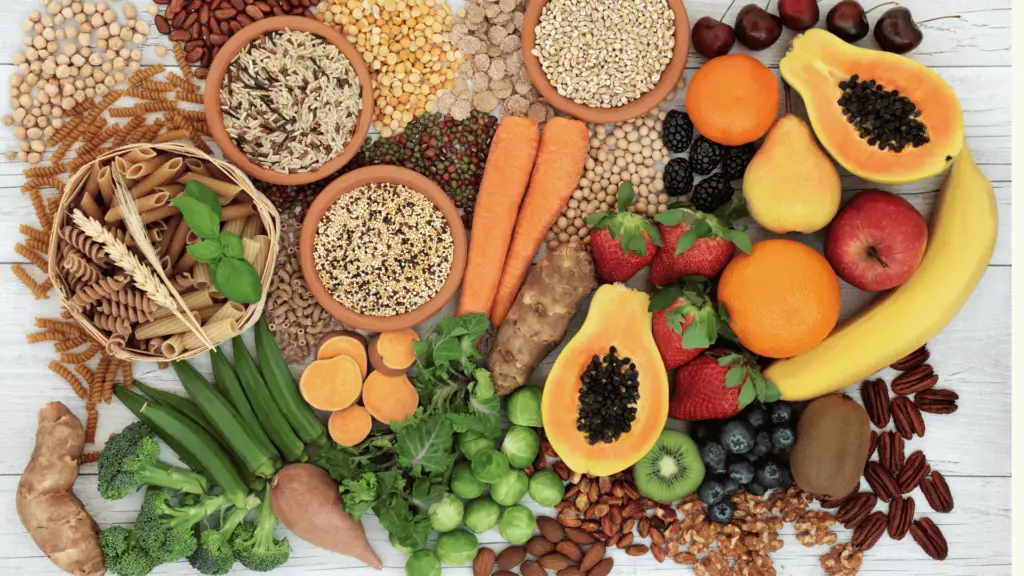When you minimize your carb intake, your body enters a metabolic process called the “ketogenic phase.”
During this transition, you may encounter some carbohydrate withdrawal symptoms, including fatigue, headaches, and nausea. However, once your body adapts to your new diet, you could start seeing amazing benefits.
In this article, we’ll explore everything you need to know about carb withdrawal.
What Are the Benefits of Cutting Out Carbohydrates or Sugar?
Although low-carb diets often result in withdrawal symptoms, there are some health benefits to gain along the way.
1. Helps With Weight Loss Programs
Generally, your body burns stored fat to get the energy it needs to function while you are on a low-carb diet.
That’s why cutting your carb intake can help with weight loss and reduce visceral fat or belly fat.
2. Lowers the Risk of Diabetes
You might know that your pancreas releases insulin to bring down blood sugar levels. Blood sugar levels need to remain within very strict limits and insulin is key in that process. However, when lots of sugar or carbs enter your body, it tries to keep up by releasing more insulin.
The more carbs and sugar you take, the more your body becomes immune to insulin, to the point where your cells completely stop responding to insulin.
Eventually, your body’s resistance to insulin results in type 2 diabetes.
However, taking fewer carbs can improve your insulin sensitivity and lower your risk of developing diabetes.
3. Protects Your Liver
According to studies, carbohydrates are associated with Non-Alcoholic Fatty Liver Disease or NAFLD.
Typically, your liver breaks down carbs. However, it also turns excess carbohydrates, like sugar, into fat and stores it in its cells. Over time, too much fat in your liver might lead to NAFLD.
4. Boosts Satiety
It’s not the calories that satiate your feelings of hunger. Instead, it’s nutrients like protein, fibers, and fats.
Unfortunately, simple carbs contain more calories, lack nutrients, and can leave you hungry. On the other hand, fibers and proteins help you feel fuller for longer.
So, if you replace carbs with high-protein foods, you can tone down the nagging feeling of hunger and go longer between meals.
5. Gives You a Chance to Build Muscle Mass
Aside from keeping you full, protein is also one of the building blocks of muscle. By consuming fewer carbs and more protein, you’re giving your muscle mass the nutrients it needs to grow.
Just eating protein doesn’t build muscle, though. Exercise to stress the muscles is the first step, then it’s your job to provide the protein to build more muscle.
Can Your Body Operate Without Carbs?
Consuming carbohydrates is the easiest way to give your body the energy it needs. Although your body can operate without carbs, you might start feeling lethargic fairly quickly.
It’s also worth noting that glucose plays a major role in nourishing the brain. Hence, drastically reducing your carb intake can impact your mood.
Will You Pass Out Without Carbohydrates?
While cutting down on carbs is a great way to shed those extra pounds, you can pass out if your blood sugar drops so low that you become hypoglycemic. It is hard to give a blanket “Yes” or “No” answer to this question because it varies depending on the person. Most people will do fine but with society’s addiction to sugar getting worse and worse, you never know.
Hypoglycemia, also known as low blood sugar, means that your glucose levels have dropped so low that your organs can’t function normally. In most people, the blood sugar level is considered low if it falls below 70 milligrams per deciliter.
If I were training a 17-year-old sedentary teenage boy who drank a 12 pack of Cokes per day, he would be feeling some serious symptoms if we had him cut it all out and I put him on the treadmill for an hour. That would actually be a very bad way to go about it.
You’ve got to do these things on a gradient. Slowly work exercise into the person’s life and slowly work carbohydrates/sugar out.

Is It Better to Train Without Carbohydrates?
While it’s been widely thought that you need carbs for training, following a low-carb diet doesn’t mean that you have to give up your workout routine. However, you still need to consider your fitness goals to find the exercise that suits you best.
For instance, endurance activities like cycling and running utilize aerobic metabolism. In contrast, more intense training that focuses on muscle activity, like weight lifting, uses anaerobic metabolism.
Although both aerobic and anaerobic workouts use glucose, anaerobic exercises push your body to use glucose as the primary energy source. While aerobic exercises rely on different sources aside from glucose, like fatty acids and amino acids.
Therefore, it might not be the best idea to cut back on carbs when you’re training anaerobically.
There are all sorts of energy gels that are just pure sugar. They help a ton when you’re needing to perform. But using these on a regular basis doesn’t train your body to do anything. The real training stress should be making your body get good at burning fat for fuel.
How Long Does It Take to Get Through Carb Withdrawal?
Depending on how much sugar/carbs you take on a daily basis, you can expect the signs of carb withdrawal to last anywhere from a couple of days to a few weeks.
What Does It Feel Like?
The exact withdrawal symptoms vary from one person to another, but the common signs include the following:
- Dizziness
- Headache
- Bad breath
- Muscle cramps
- GIT disturbances (constipation, nausea, diarrhea, etc.)
- Changes in mood and sleep patterns
- Difficulty concentrating
- Sweet cravings
Does It Get Better?
Yes, some people report that the withdrawal symptoms get easier with time, but you have to push through the first week.
How to Cope With Carbohydrate Withdrawals
While your body tries to adjust to your new diet, you can cope with the symptoms by following these tips:
1. Keep a Glass of Water Nearby
Aside from quenching your thirst and keeping you hydrated, a cool glass of water can help you feel full throughout the day.
Some people find that adding a natural sweetener improves the flavor and encourages them to take a sip more often. So, you can try using lemon slices, orange slices, berries, cucumbers, or mint leaves.
However you do it, get the water in.
2. Go Easy With the Workout Sessions
You might want to stick to light exercises for the first few days of your low-carb diet. This will give your body some time to adjust gradually to its new sources of energy.
Keep in mind that it’s important to let your body rest, especially if you’re experiencing symptoms like muscle cramps and fatigue.
Try to avoid exercises like weight lifting, intense biking, and running. Instead, opt for yoga sessions or light jogs around the neighborhood.
3. Find a Support Community
Going through carb withdrawal is a difficult journey, so it might help if you surround yourself with people who are aware of what you’re going through.
You can always team up with someone with the same fitness goals and share experiences and tips.
Misery loves company. But trust me, the long-term benefits are worth it.
4. Replace Carbs With Fibers

Jumping into a low-carb diet can naturally result in cravings for high-carb and sugary food, and one way to tackle that is by compensating with fiber.
After all, fibers can bulk up the stomach and promote an increased feeling of satiety.
5. Include More Protein in Your Diet
Studies show that food high in protein keeps you feeling full for a longer time.
High-protein foods include fish, chicken, quinoa, chia seeds, and almonds, all of which can make mouthwatering dishes. So, you don’t have to put up with boring meals just because you’re going through carb withdrawal!
6. Increase Your Healthy Fat Intake
Aside from protein, fat is a key energy source of your body. So, you can use it to compensate for the missing carbs in your diet. However, it’s still important to note that not all fats are good for you. Trans fats and hydrogenated oils should be avoided.
For instance, polyunsaturated and monounsaturated fats are considered healthy fats. Look for healthy snacks that incorporate avocados, nuts, legumes, or peanut butter. I also think that the world is coming around to the fact that saturated fats aren’t so bad as earlier suggested. But that’s a hot topic.
7. Stay Positive
Going through carb withdrawal is an uncomfortable process, and you’ll need to hold on to every bit of positivity and motivation along the way. One way to do that is to reward yourself and celebrate even the smallest milestones. Mark off a calendar for every day of your first week. Make it visual.
In addition, some outdoor time can keep your mind off your withdrawal symptoms. So, whenever the cravings hit, try to keep yourself busy with physical activity. Remember that while eating carbs and sugar helps with boredom, it’s only a short-term solution. It’s up to you to find another way to fill that time.
On top of that, we’d recommend finding ways to relax and calm down the irritation that comes with the carb withdrawal phase. Get a variety of exotic teas and try them out. Get an audiobook and go clean the garage while listening to it. However you do it, stick with it and your body will adjust.
8. Get a Good Night’s Sleep

Getting adequate sleep can also help you cope with carbohydrate withdrawal. After all, not getting enough rest can contribute to your cravings for sugary snacks.
Typically, the recommended amount of sleep for adults is seven to eight hours. If you struggle to fall asleep early, you can try lessening your exposure to blue lights from electronic devices, such as laptops, televisions, and cell phones. You can also try stretching your muscles thoroughly before you go to bed. That has helped me a ton in the past.
It’s definitely not easy but reducing your caffeine intake can also help. Whether or not you want to quit caffeine and carbs at the same time is up to you.
Wrapping Up
People adapt differently to low-carb diets. Some might experience mild symptoms of carbohydrate withdrawal, while others can adjust without any notable side effects.
You can cope by drinking lots of water, balancing your diet, and getting adequate sleep every night. You can also adjust your workout routine initially to let your body adjust to the change.
Remember that the key is staying positive. This might mean reaching out to people with similar experiences, teaming up with a partner, going for light exercise sessions, or finding relaxing activities.
For more information, check out my article on Low Glycemic Index Diets.


